Vermont State Police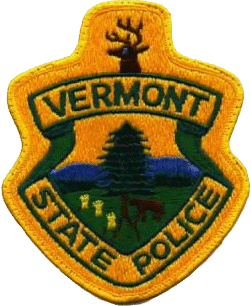
Vermont State Police
The first bill to establish a Department of Public Safety/State Police was introduced in the 1937 Vermont Legislature, yet it was not to be. The defeat of the original proposal has been attributed to lobbying by the county sheriffs who perceived a loss of power and a conservative legislature with a tight hold on the purse strings.
The disappearance of an eighteen year old Bennington College student in 1947 resulted in changes to the attitudes of many opponents of the formation of a Department of Public Safety. Bennington county officials were unsuccessful in locating the student and were forced to call on State Police investigators from Connecticut and New York for assistance.
Tragically the case was never solved. This case, plus the Governor of Vermont's efforts ended a decade-long struggle with the Vermont Legislature passing Act No. 163. Finally, on July 1, 1947, the Vermont Department of Public Safety and thus , the Vermont State Police became a reality. Prior to that date, Vermont law enforcement was primarily county based. Each of the state's fourteen counties had an elected sheriff responsible for providing all law enforcement services to towns in the county without their own police departments.
On the state level, only the Department of Motor Vehicles Highway Patrol provided centralized, statewide law enforcement services. Members of that Department patrolled the state's roadways on motorcycles enforcing motor vehicle law and investigating accidents. The original strength authorized for the Department was 62, with 7 civilians and 55 troopers. Twenty-seven officers transferred from the Highway Patrol to the DPS.
In 1948, the Department purchased 25 Ford sedans, two Pontiac sedans, and one Pontiac coupe for a total price of $14,742.41. The Departmental strength was 118 State Police and 60 civilians at the beginning of 1960. The state's population was 389,881. There were only 41.4 miles of Interstate highway compared with 320 miles in 1998.
The Department grew to 193 State Police and 85 civilians by June 30, 1970, and by the end of the decade the State's population had grown to 477,427. There were 383,108 registered vehicles and 352,715 licensed drivers. The Department strength grew to 259 State Police and 120 civilians. Changes continue to be made throughout the Department. A recent reorganization resulted in going from five to four Troop areas. Dispatching services were being consolidated with a pilot project in Rockingham/Brattleboro/Shaftsbury.
Today, the Vermont State Police is a full service law enforcement agency consisting of 328 sworn officers and 90 emergency telecommunicators. The Department provides primary police services for about 50 percent of Vermont's population which includes approximately 200 towns representing 90 percent of Vermont's land area. In addition to the traditional police services of traffic enforcement and the investigation of crimes, Troopers enforce snowmobile and recreational boating laws.
Prior to the formation of the Vermont State Police in 1947, there existed Vermont Motor Vehicle Inspectors under the Secretary of State's Office beginning in 1919. In 1927, the state Motor Vehicle Department was formed and staffed by inspectors of the Vermont Commissioner of Motor Vehicles. These state motor vehicle inspectors enforced motor vehicle laws on the state's highways. Motorcycles were the sole mechanical transportation of the Highway Patrol from 1919 until the first sedan was put into service in 1937. License plates used by the agency were standard Vermont motorcycle license plates using one and two digit numbers. From 1937 until approximately 1949 (two years after the creation of the VSP), patrol cars of the Highway Patrol used State Vehicle ST-prefixed license plates in the ST-1## format that matched the same color/layout as the regular passenger car plates of the day.
1947 introduced aluminum as the stock of choice for the state's license plates. State vehicle license plates during this inaugural year of the Vermont State Police measured 6" x 10" as the previous issues, but with white characters over a black background. ST ### over 47 VERMONT.
1948 was the first year for a slogan for Vermont license plates. The deep yellow over green aluminum plates had the slogan GREEN MOUNTAINS embossed along the top and centered between the upper mounting holes. The ST ### format for state vehicles continued and was placed over 48 VERMONT.
It is believed based on more recent photographic evidence, that titled Vermont State Police license plates began in 1949, however it is possible that state vehicle license plates may have also been used by the VSP during this time frame leading into the early 1950's.

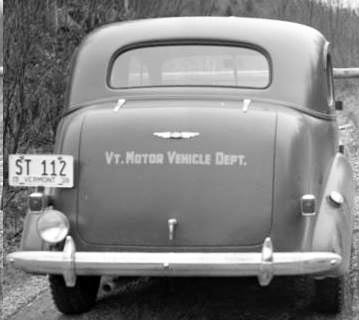 1938- Vermont Highway Patrol (MVD) using State Vehicle plate
1938- Vermont Highway Patrol (MVD) using State Vehicle plate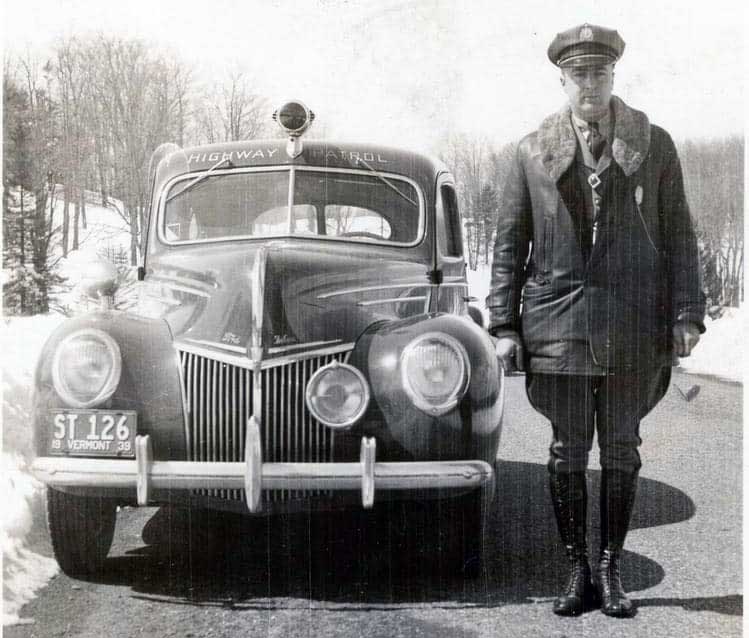 1939- Vermont Highway Patrol (MVD) using State Vehicle plate.
1939- Vermont Highway Patrol (MVD) using State Vehicle plate. 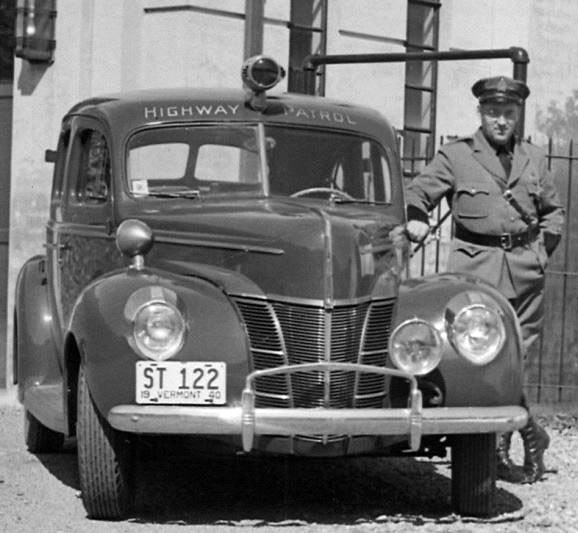 1940- Vermont Highway Patrol (MVD) using State Vehicle plate.
1940- Vermont Highway Patrol (MVD) using State Vehicle plate. 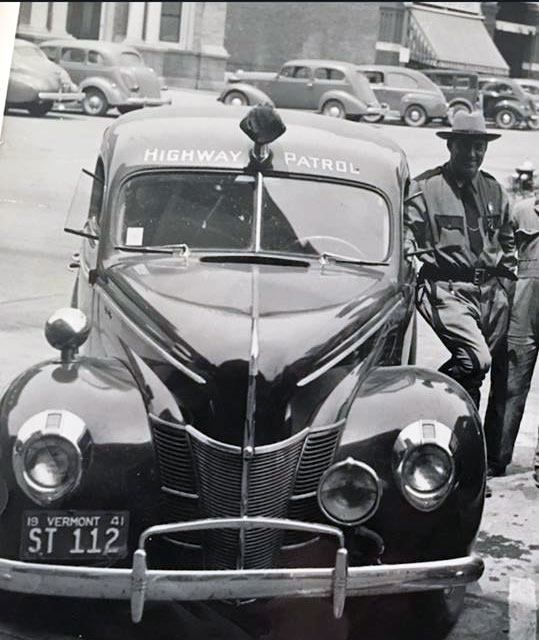 1941- Vermont Highway Patrol (MVD) using State Vehicle plate.
1941- Vermont Highway Patrol (MVD) using State Vehicle plate. 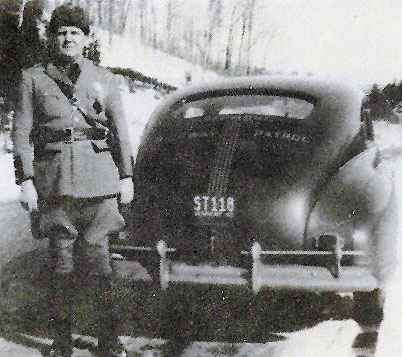 1945- Vermont Highway Patrol (MVD) using State Vehicle plate
1945- Vermont Highway Patrol (MVD) using State Vehicle plate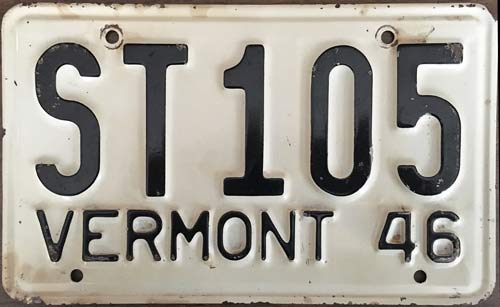 1946 State Vehicle issue.
1946 State Vehicle issue. 
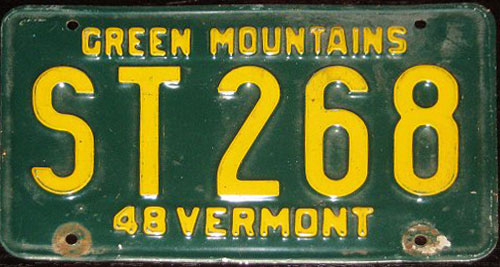 1948 State Vehicle issue.
1948 State Vehicle issue. 
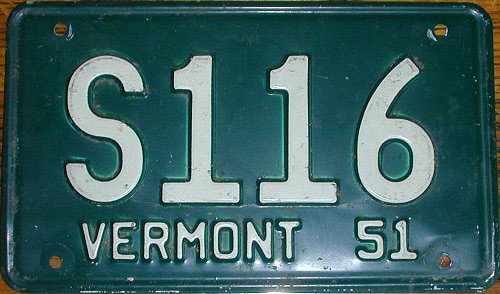 1951 State Vehicle issue. Embossed aluminum.
1951 State Vehicle issue. Embossed aluminum.
The recent discovery of the photo seen below this paragraph indicates that the first-issue titled STATE POLICE license plates for the Vermont State Police were introduced much earlier than 1954 as previously believed.
The photo shows a 1949 Ford in VSP markings with a VSP trooper standing next to it. The car bears the titled Vermont STATE POLICE license plate number 38.
The plate is believed to be made of silkscreened steel and measures 6" x 13". The plate is a silkscreened application in green over off-white, almost cream which can be attributed to the reflective material used where the white background often turned to a more gold or "champagne" hue with age and exposure to the elements. The state name was situated at the top center of the plate. The assignment number up to two digits occupied the right 1/3 of the plate and STATE over POLICE occupied the remaining 2/3 of the plate. There was a green silkscreened border outline as well.
This first issue titled VSP license plate was painted white on the back-side.
This sturdy license plate was used on the marked VSP fleet until approximately 1957.
As the years went by, other versions of this same layout appeared as a replacement, but rather than being made of steel with a painted back-side, it was made of sign grade aluminum and not painted at all on the back-side.
Background colors varied from the jaundiced hue to brighter, almost silvery reflective material.
Otherwise, the measurements and appearance was almost identical to the original.
All Vermont State Police license plates were transferable from older vehicles to newer ones, hence why wear patterns over mounting holes can differ and extra mounting holes can be seen on some examples. That trend still continues.
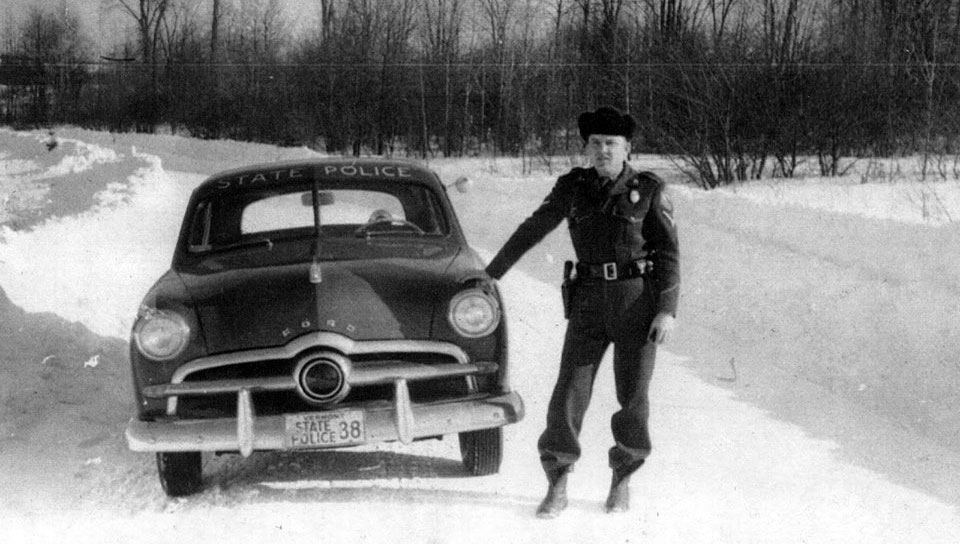
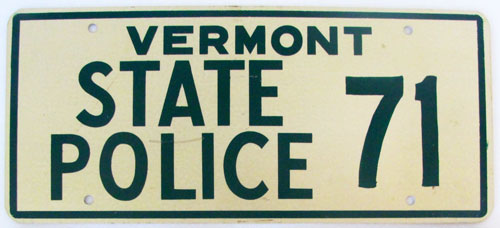 1949-c.1957 Silkscreened thick steel issue,
1949-c.1957 Silkscreened thick steel issue,
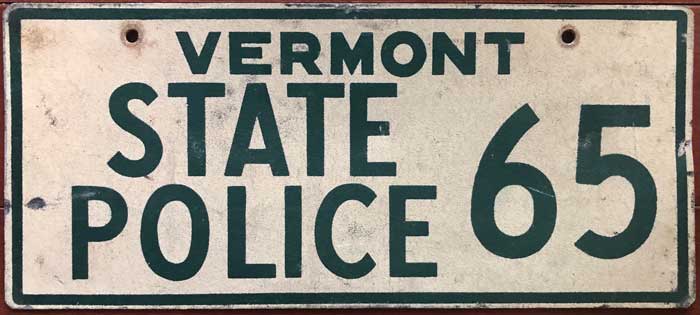 1949-C.1957 Silkscreened aluminum issue.
1949-C.1957 Silkscreened aluminum issue.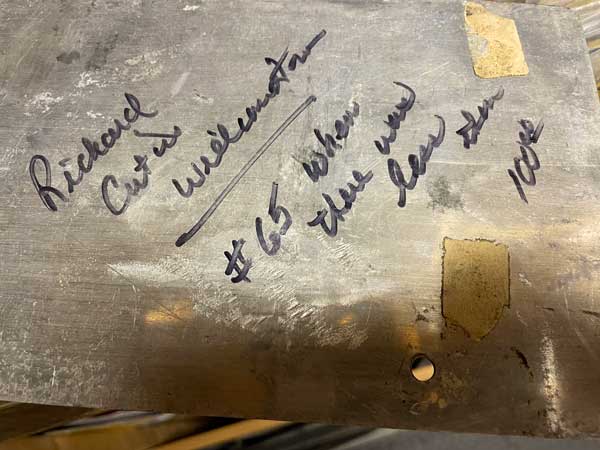 Inscription on back of license plate used by Richard Curtiss while stationed in Williamstown ("#65 when there was less than 100")
Inscription on back of license plate used by Richard Curtiss while stationed in Williamstown ("#65 when there was less than 100") 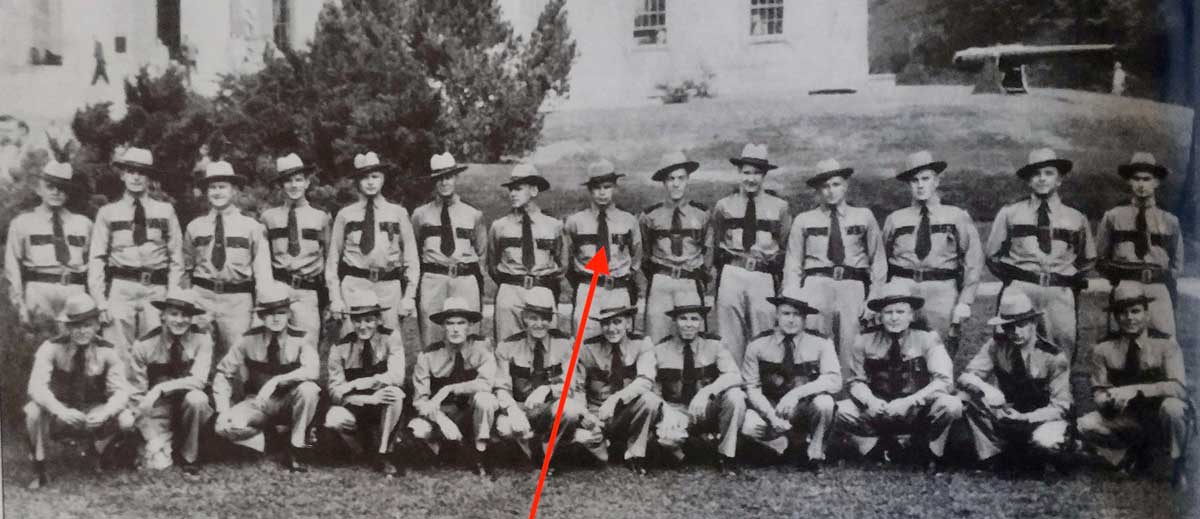 Richard Curtiss in Class # 1 (1947)
Richard Curtiss in Class # 1 (1947) 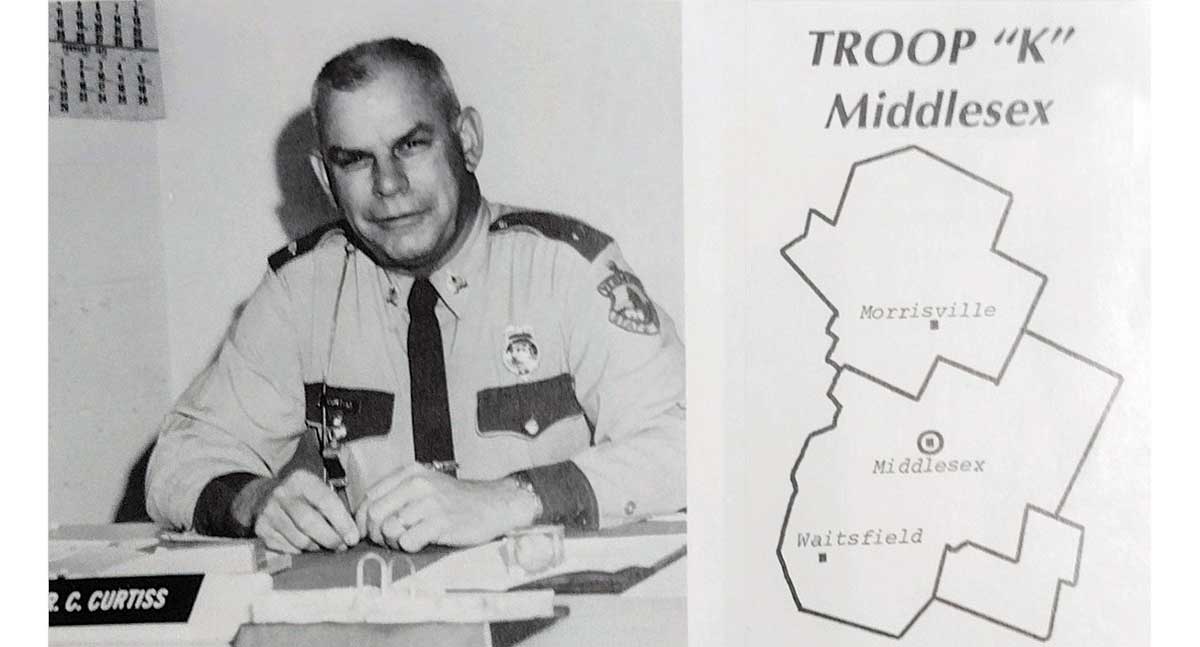 Richard Curtiss as Troop K (Middlesex) Commander before retirement in 1976
Richard Curtiss as Troop K (Middlesex) Commander before retirement in 1976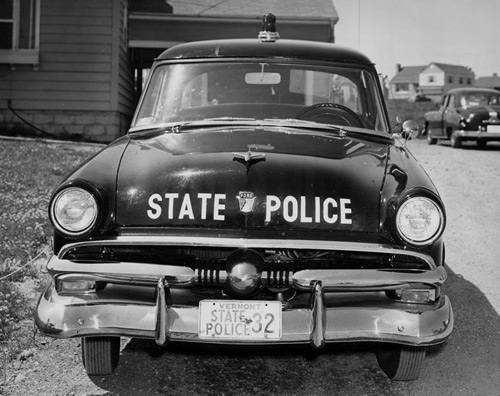
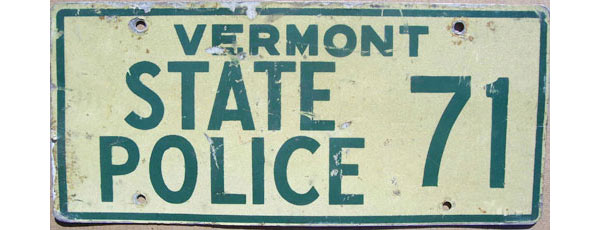 1949-c.1957 Silkscreened thick aluminum.
1949-c.1957 Silkscreened thick aluminum.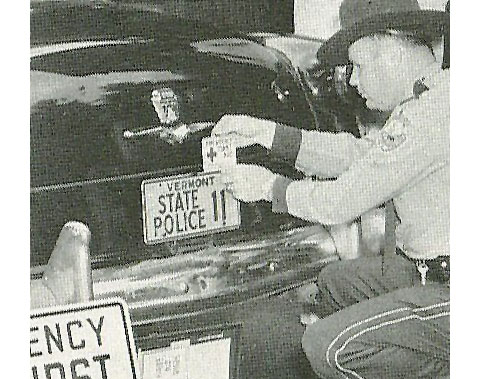
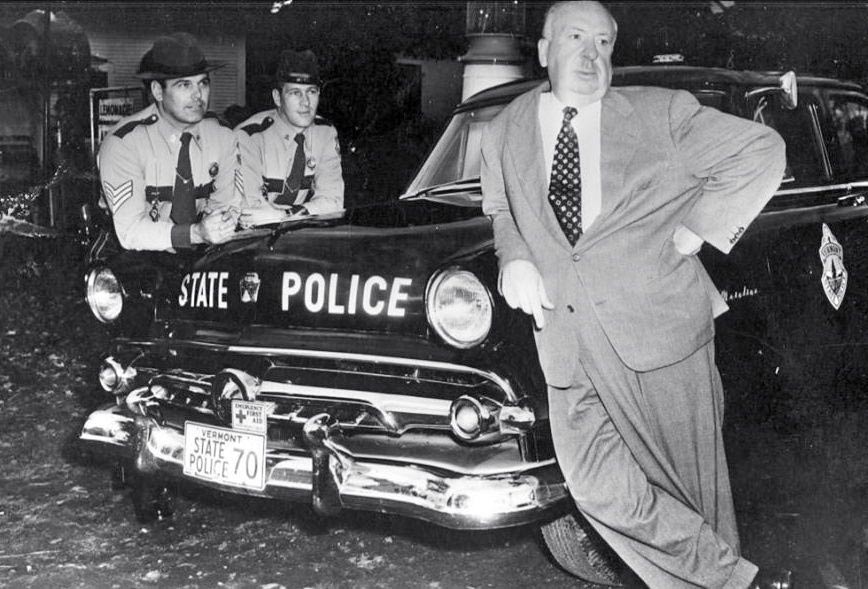
Photo taken in 1955 showing famed film director Alfred Hitchcock leaning against Vermont State Police car number 70 during the filming of "The Trouble With Harry". I have been told that the Sergeant seen at left of the photo was the newly-promoted Glenn Davis whose plate # 71 seen above was assigned......just ONE NUMBER OFF from the one seen in this great old photo...
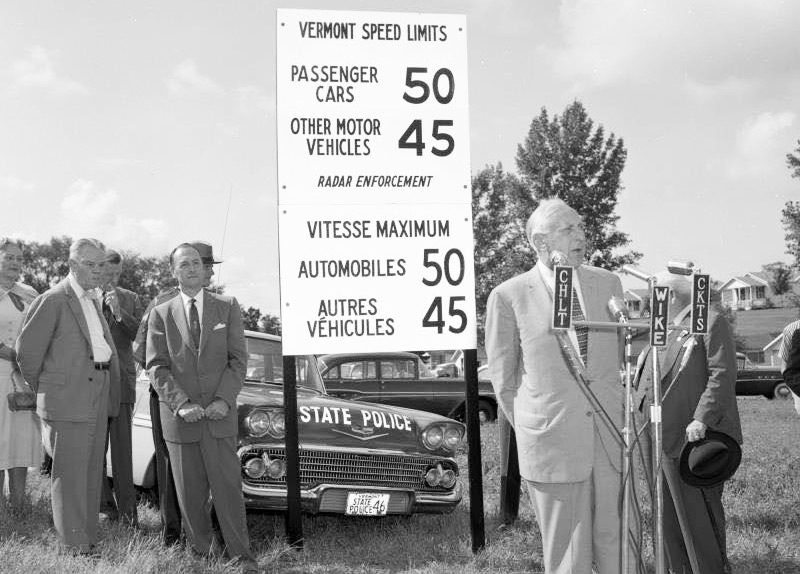 Circa 1956 press conference at the border between Derby Vermont and Stanstead Quebec in Canada. The message was to advise of the radar enforced speed limits in the state of Vermont to motorists of Quebec who were known to have a heavier foot on the gas pedal.
Circa 1956 press conference at the border between Derby Vermont and Stanstead Quebec in Canada. The message was to advise of the radar enforced speed limits in the state of Vermont to motorists of Quebec who were known to have a heavier foot on the gas pedal.
The postings were in French as well as English as fair warning.
The VSP Chevrolet in the background is still sporting the older VSP license plate.
Around late 1956, shortly after the 6" x 12" license plate measurement standard came out, the license plates of the Vermont State Police followed suit using the same green over reflective white silkscreened coloring and the format of STATE over POLICE placed on the left side of the plate followed by an assignment number up to two digits. The state name was eliminated from this base plate.
These plates were used until a new type was introduced in 1963, however there were a couple of versions to this license plate which would differentiate newer types from older types.
The newer types had the STATE over POLICE moved closer to the left margin of the plate to allow a three digit number as the VSP fleet increased in size during the early 1960's.
The earlier ones have STATE over POLICE placed closer to the center, usually with the S of STATE placed directly below the upper left mounting hole.
Heavy steel was used for these plates. It was beleived that later ones were made of aluminum, but none of this type utilizing aluminum have surfaced yet for confirmation.
Both types are painted white on the back side.
All Vermont State Police license plates were transferable from older vehicles to newer ones, hence why wear patterns over mounting holes can differ and extra mounting holes can be seen on some examples.
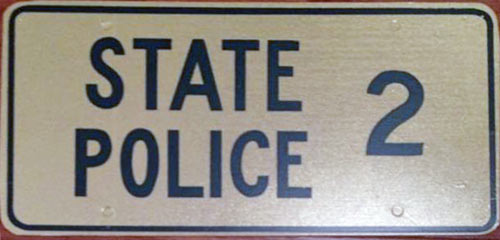 C.1956-1963 issue.
C.1956-1963 issue. 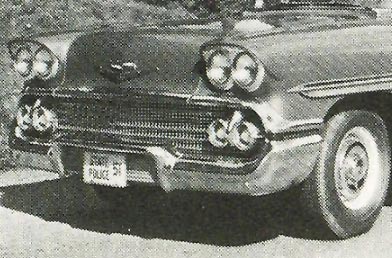 VSP license plate # 51- Circa 1958
VSP license plate # 51- Circa 1958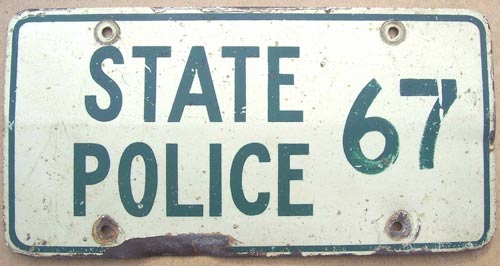 C.1956-1963 issue.
C.1956-1963 issue. 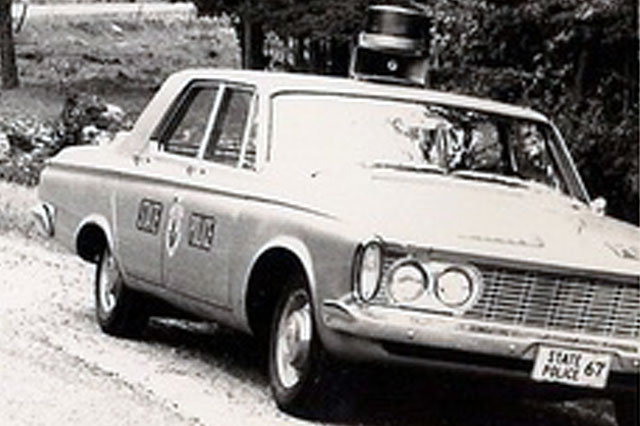 VSP license plate number 67 (seen at left)-- on duty!
VSP license plate number 67 (seen at left)-- on duty!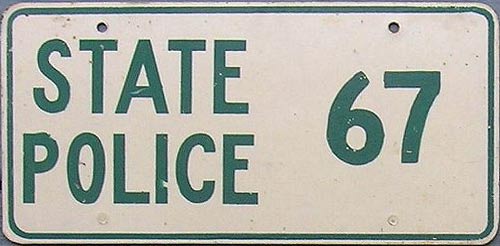 C.1956-1963 issue.
C.1956-1963 issue. 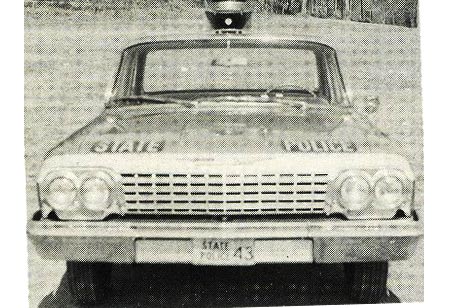 Circa 1962- Larger font for number.
Circa 1962- Larger font for number.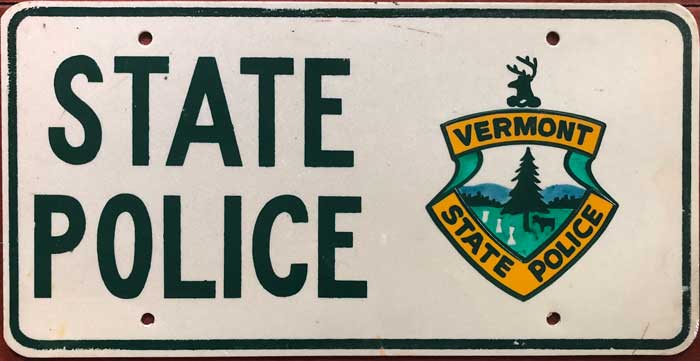 1956-1963- Issued to (Captain) Paul Huntley of Troop D.
1956-1963- Issued to (Captain) Paul Huntley of Troop D.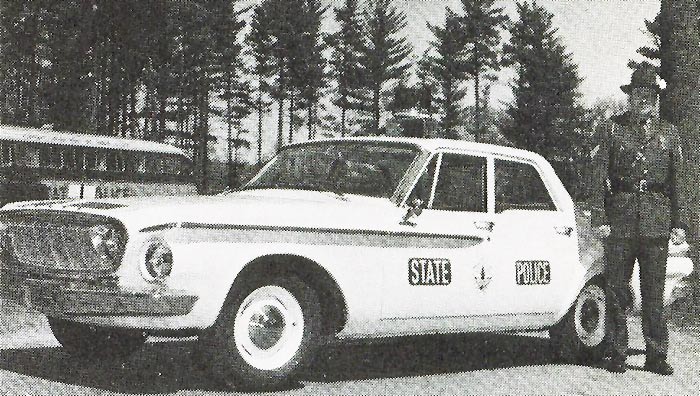
In 1963, the Vermont State Police introduced an entirely new license plate. The embossed borderless aluminum plate was colored dark green over reflective white. VERMONT was embossed at the top center just below the upper mounting holes. STATE over POLICE was embossed to the left center of the plate and a number up to 3 digits occupied the right center of the plate.
This type was also distinctive by being said to be the first VSP license plate issue to feature Troop number assignments.
There is no confirmation that Troop assignments went this far back, however, with the numbering on these bases going into the 400 and 500 series, it can be surmised that these were not sequential numbers as the VSP marked fleet was nowhere near that large at that time.
Confirmation either way would be helpful.
Headquarters and special assignment numbers were from 1 to 99.
Troop plates were assigned as such:
200 series: Troop A (Williston, St. Albans and Middlesex Barracks)
300 series: Troop B (St. Johnsbury, Derby and Bradford Barracks)
400 series: Troop C (Rutland, New Haven and Shaftsbury Barracks)
500 series: Troop D (Rockingham, Brattleboro, and Royalton Barracks)
These plates were used by the Vermont State Police until a new issue came out around 1970.
All Vermont State Police license plates were transferable from older vehicles to newer ones, hence why wear patterns over mounting holes can differ and extra mounting holes can be seen on some examples.
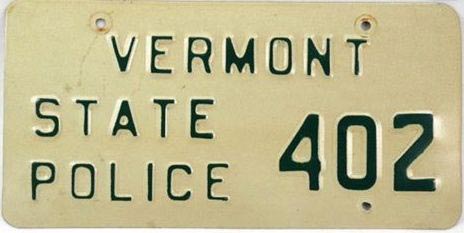 1963-1970 issue. Embossed aluminum.
1963-1970 issue. Embossed aluminum.
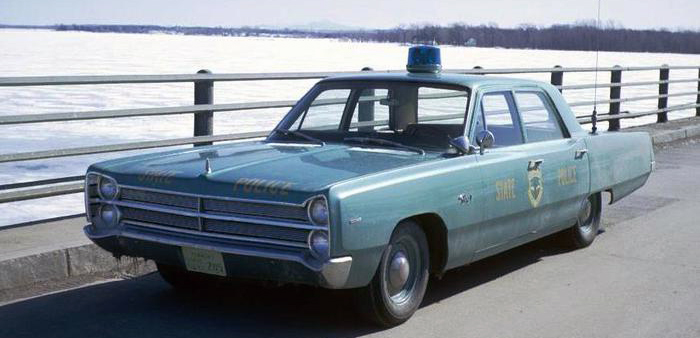
It is believed that as early as 1970, the Vermont State Police began using a totally different design for its license plates.
These plates were made of DEBOSSED aluminum, meaning that rather than having raised characters, they were concave.
The colors were reflective yellow over reflective green. VERMONT was debossed at the top center of the plate. STATE POLICE was debossed in larger font along the bottom of the plate and just above the lower mounting holes.
Some have a shade of yellow lighter than others, while some can have a deeper yellow, almost gold-like shade. Many of these types were validated with annual decals with October expiry while others were not.
The same Troop numbering continued on this base with some additions.
Of particular note was the introduction of Troop K (Middlesex) which would now run VSP license plates in the 600 series. This troop was situated in and around Washington County, halfway between Montpelier and Waterbury.
Troop K eventually amalgamated with Troops A and D sometime later.
Also, in 1976-1977, Troop I (Interstate) was created as a result of a federal grant to increase traffic safety on the interstate highways of Vermont. Troop I was issued with VSP license plates in the 700 series.
Prior to this troop's formation, there was no dedicated assignment for patrolling Interstates 89 and 91...this proved troublesome particularly for the Winter months.
The 700 series license plates began with 700 assigned to the Troop Commander (Lt. Ed Fish at that time), 701 to the Station Commander, 702, 703 and 704 to Patrol Commanders and so on.
By around 1980, Troop I was dissolved and absorbed into the respective traditional troop areas.
Although Troop I no longer exists, the 700 series of VSP license plates were re-assigned to state headquarters to eventually be attributed to the Commercial Vehicle Enforcement Unit with 705 going to the Sergeant in charge of that unit. The 700 series also includes a DUI Saturation Patrol, as well as a traffic operations unit with a trooper assigned to each troop.
Our thanks to Russ Penka for this historical information about Troops I and K.
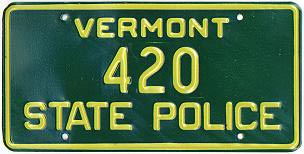 1970-1984 issue. Debossed aluminum.
1970-1984 issue. Debossed aluminum.
 422 Getting tagged in Rutland
422 Getting tagged in Rutland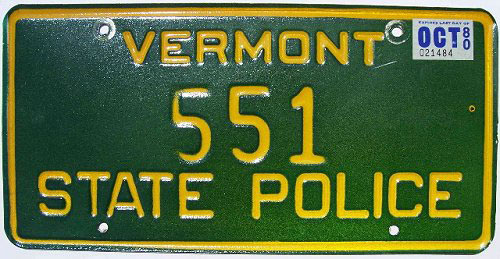 1970-1984 issue. Debossed aluminum.
1970-1984 issue. Debossed aluminum.
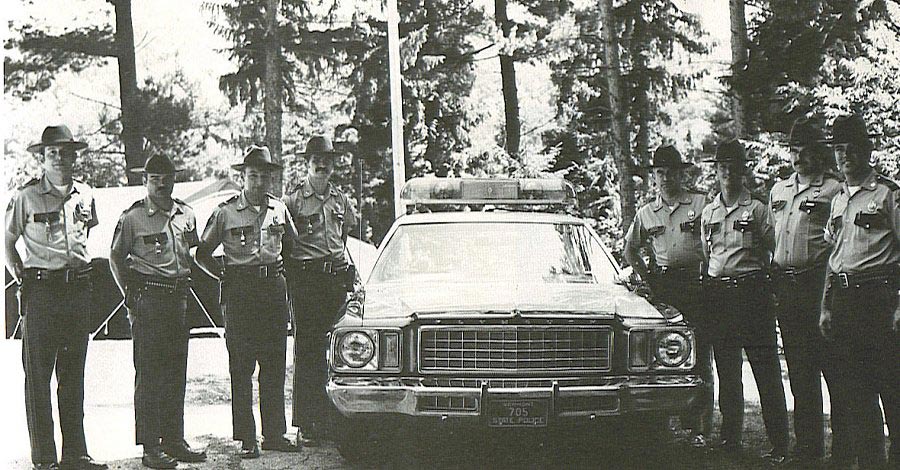
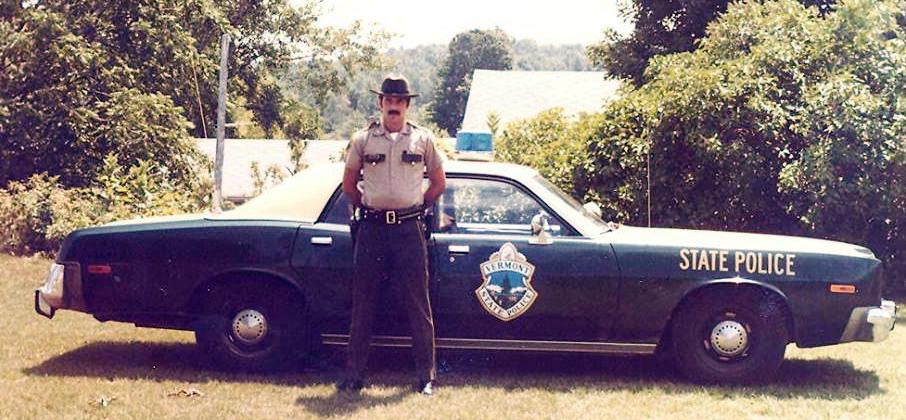
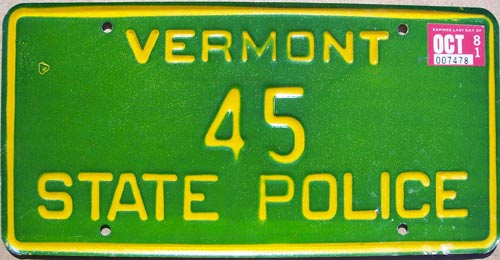 1970-1984 issue. Debossed aluminum.
1970-1984 issue. Debossed aluminum. 
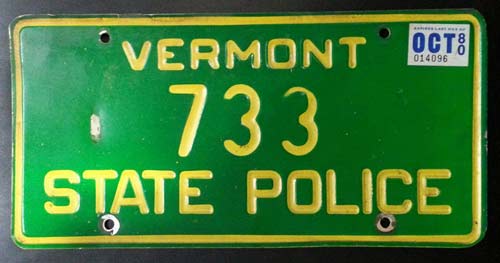 1970-1984 issue. Debossed alumium.
1970-1984 issue. Debossed alumium.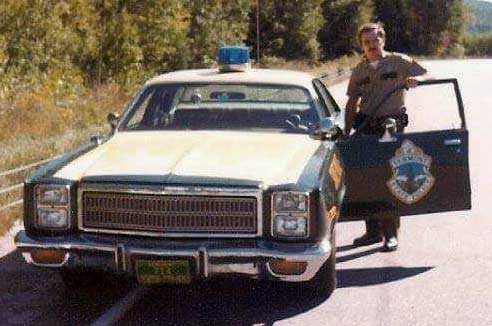 1978 # 714 - Courtesy Chris Fretta
1978 # 714 - Courtesy Chris FrettaIn late 1984 to early 1985, the Vermont State Police, for reasons unknown, decided to depart from their titled state police license plates in favor of going back to using a generic state vehicle plate for their marked vehicles.
The reflective white over green debossed aluminum plates utilized silkscreened graphics for the state name and slogan. Vermont was screened in a stylized white font at the top center of the plate with a design of a maple tree in the top left corner also silkscreened in white.
The slogan "Green Mountain State" was screened in white between the lower mounting holes.
The prefix STATE was debossed in a descending right oblique at the left center of the plate followed by the letter S and three numbers based on VSP Troop number blocs. The characters were all debossed in white and situated on a raised platform outlined in white, forming a white rectangular outline around the characters.
These plates were used until the Vermont State Police went back to a fully-titled STATE POLICE license plate in late 1990/early 1991.
Annual validation decals with October expiry were applied to the bottom right corner of the plate.
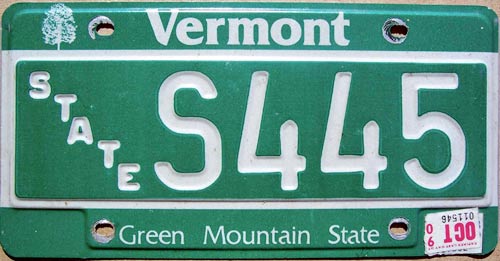 1985-1990 state vehicle issue. Debossed aluminum.
1985-1990 state vehicle issue. Debossed aluminum.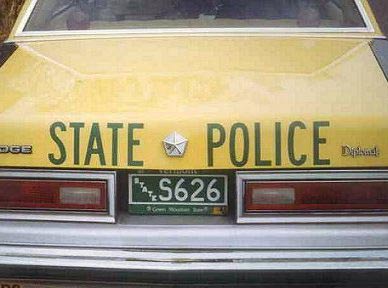 600 series: Troop K- Car 26 with October 1987 expiry.
600 series: Troop K- Car 26 with October 1987 expiry.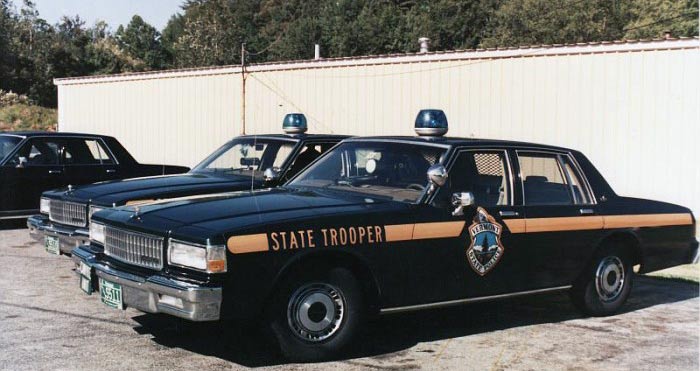
 1985-1990 state vehicle issue. Debossed aluminum.
1985-1990 state vehicle issue. Debossed aluminum.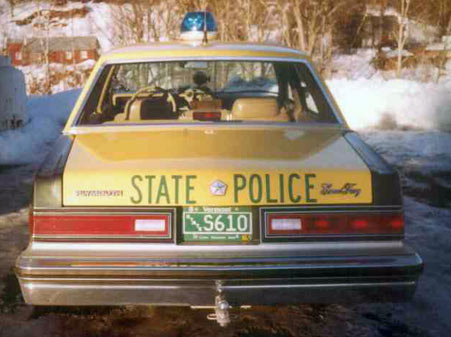 600 series: Troop K- Car 10 with October 1987 expiry.
600 series: Troop K- Car 10 with October 1987 expiry.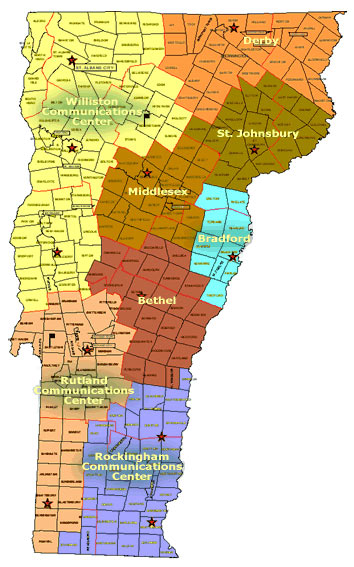
Sometime in 1990, the Vermont State Police saw the return of their titled STATE POLICE license plates.
The reflective yellow over green debossed aluminum plates utilized similar silkscreened graphics for the state name and STATE POLICE. Vermont was screened in the same stylized font as the previous issue, but in yellow with the same design of a maple tree in the top left corner also silkscreened in yellow.
STATE POLICE was screened in yellow between the lower mounting holes.
The Troop assignment number was prefixed by the letter S. The characters were all debossed in yellow and situated on a raised platform outlined in yellow, forming a yellow rectangular outline around the characters.
The later versions of these plates that came out around 1992, dropped the S prefix and went to a narrower die for the numbers.
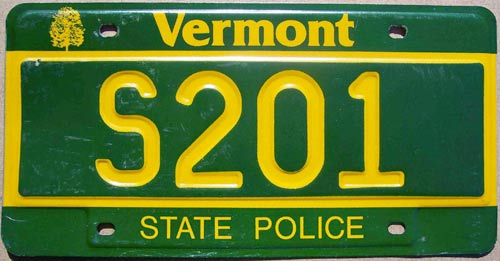 1991-1992 issue. Debossed aluminum.
1991-1992 issue. Debossed aluminum.
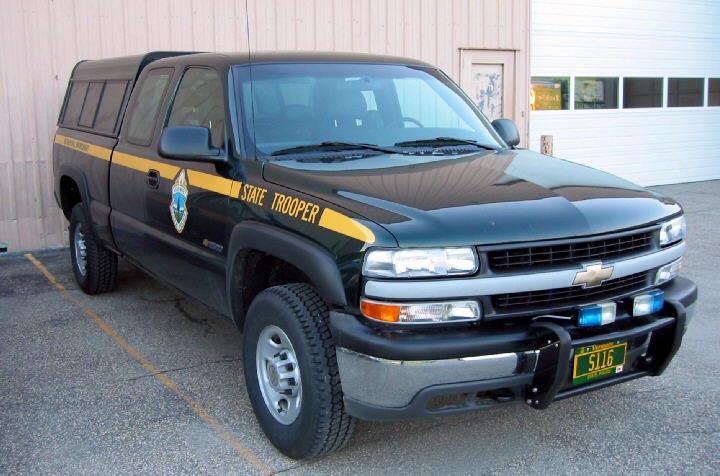
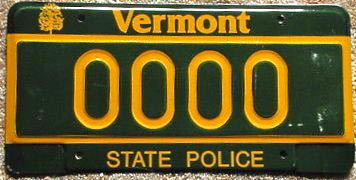 1991-1992 SAMPLE issue.
1991-1992 SAMPLE issue. 
Around 1992, a slight change took place on the license plates of the Vermont State Police.
The color and layout were the exact same as the previous issue, however the S prefix was dropped, leaving an all-numeric registration number, and narrower dies were used for the numerals.
The shades of yellow and green were also lighter.
Annual validation decals with October expiry were used once again.
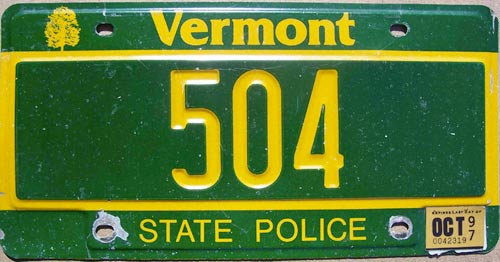 1992-1997 issue. Debossed aluminum.
1992-1997 issue. Debossed aluminum.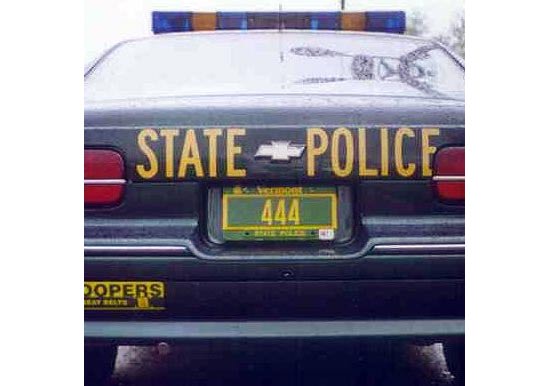 400 series: Troop C- Car 44
400 series: Troop C- Car 44 The great VSP Troop C Corporal, State Trooper Association President and SP-HP collector, Russ Penka with his also-great VSP Chevy Caprice flying #440.
The great VSP Troop C Corporal, State Trooper Association President and SP-HP collector, Russ Penka with his also-great VSP Chevy Caprice flying #440.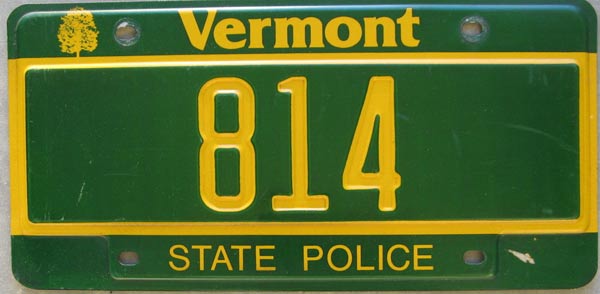 1992-1997 issue. Debossed aluminum.
1992-1997 issue. Debossed aluminum.
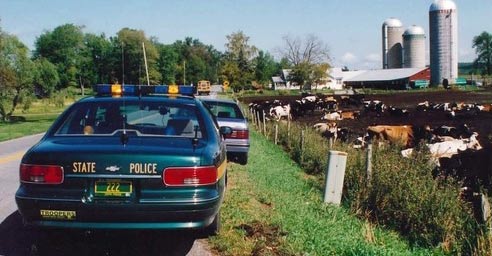
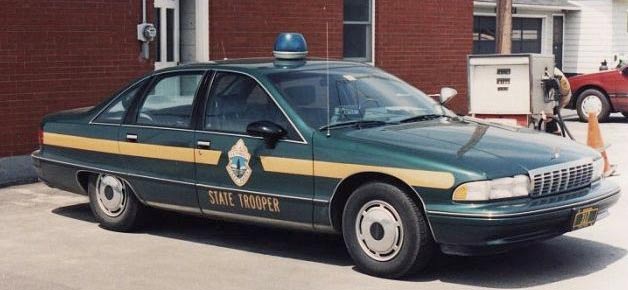
1997 saw the Vermont State Police celebrating its 50th Anniversary milestone. As a means of commemorating their Golden Anniversary, they commissioned an absolutely stunning graphic license plate for that year. It is arguably one of the most attractive designs ever developed for a state police/highway patrol agency.
The fully-silkscreened aluminum license plate has a lightly-embossed t-styled application which is ubiquitous to the manufacture of all Vermont license plates for larger vehicles during that time. The backgound of the plate features white clouds over a blue sky at the top of the plate which descends into a foggy shade of white to darkening shades of green mountains towards the bottom of the plate. The state name is silkscreened in very dark green at the top center of the plate and STATE POLICE is screened in bright yellow trimmed in dark green at the bottom center. A full-colored image of the VSP 50th Anniversary badge is situated to the far left field of the plate followed by the number in bright yellow and trimmed in dark green.
The numbers are not silkscreened, but rather applied decals.
The plates were used until 2002.
Annual validation decals with October expiry were used once again.
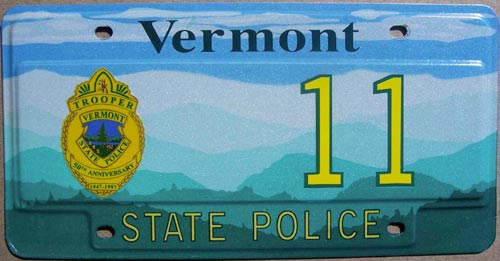 1997 50th Anniversary issue. Silkscreened aluminum.
1997 50th Anniversary issue. Silkscreened aluminum.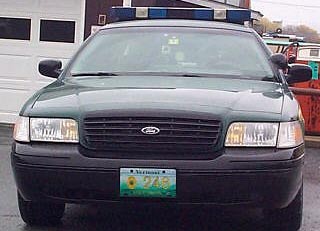 200 series: Troop A- Car 48
200 series: Troop A- Car 48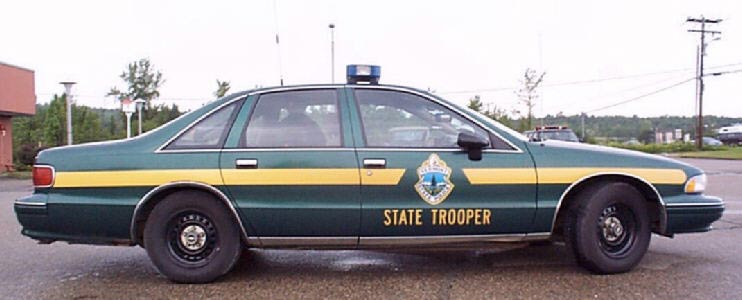
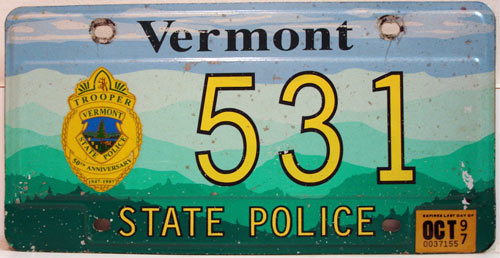 1997 50th Anniversary issue. Silkscreened aluminum.
1997 50th Anniversary issue. Silkscreened aluminum.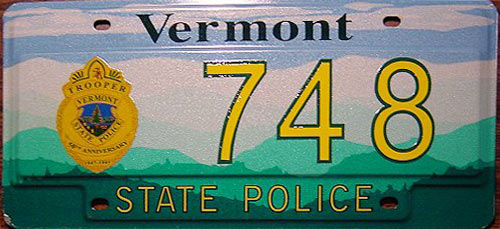 1997 50th Anniversary issue. Silkscreened aluminum.
1997 50th Anniversary issue. Silkscreened aluminum.When the attractive 50th Anniversary license plates were retired in 2002, the Vermont State Police went back to the more austere yellow over green license plates again.
The plates were almost identical to the previous issue used from 1991 until 1997, however the maple tree motif in the top left corner of the plate was dropped and the font for STATE POLICE at the bottom of the plate was more stylized.
Annual validation decals with October expiry were used once again.
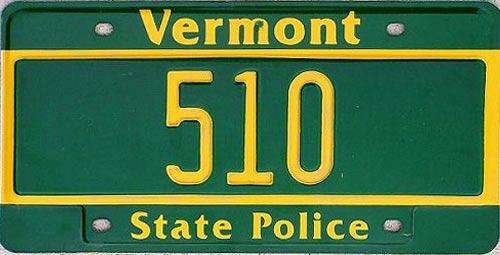 2002-Current issue.
2002-Current issue. 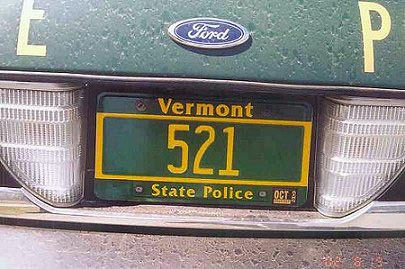 2002- Troop D- Car 21
2002- Troop D- Car 21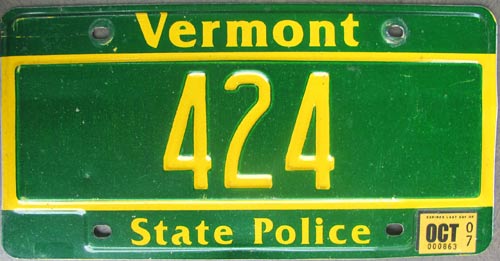 2002-Current issue.
2002-Current issue. 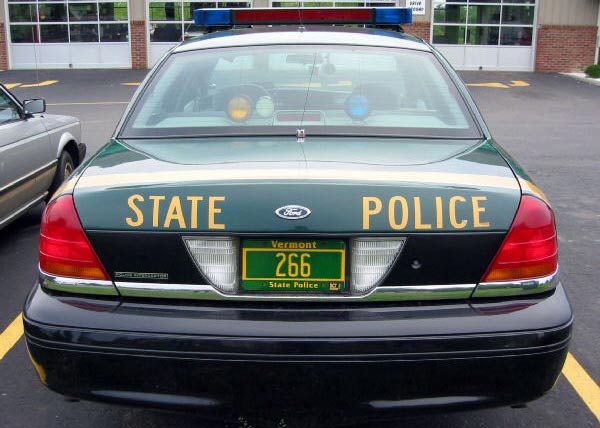 Troop A- Car 66
Troop A- Car 66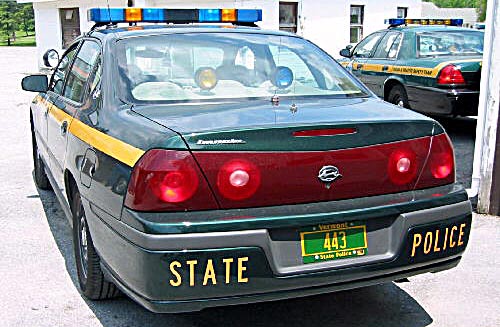
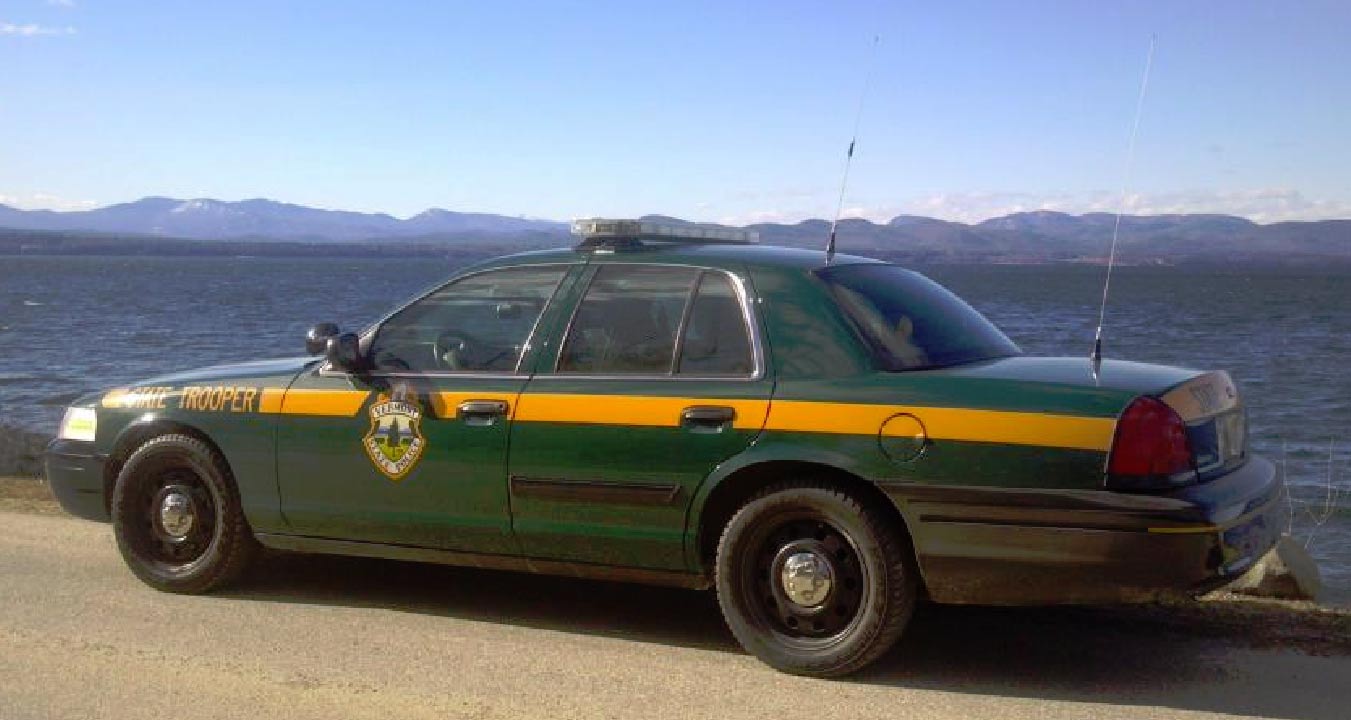
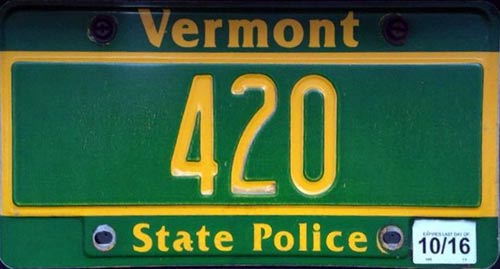 2002-Current issue.
2002-Current issue. 
 2002-Current issue.
2002-Current issue. 
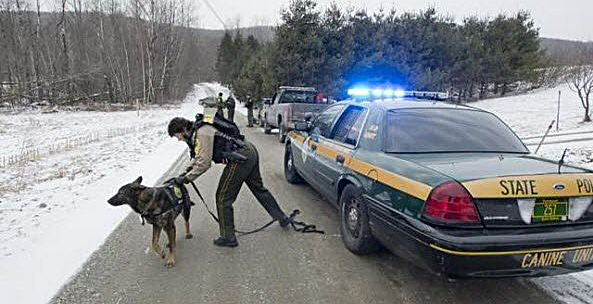
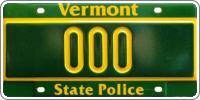 2002-Current SAMPLE issue.
2002-Current SAMPLE issue. 

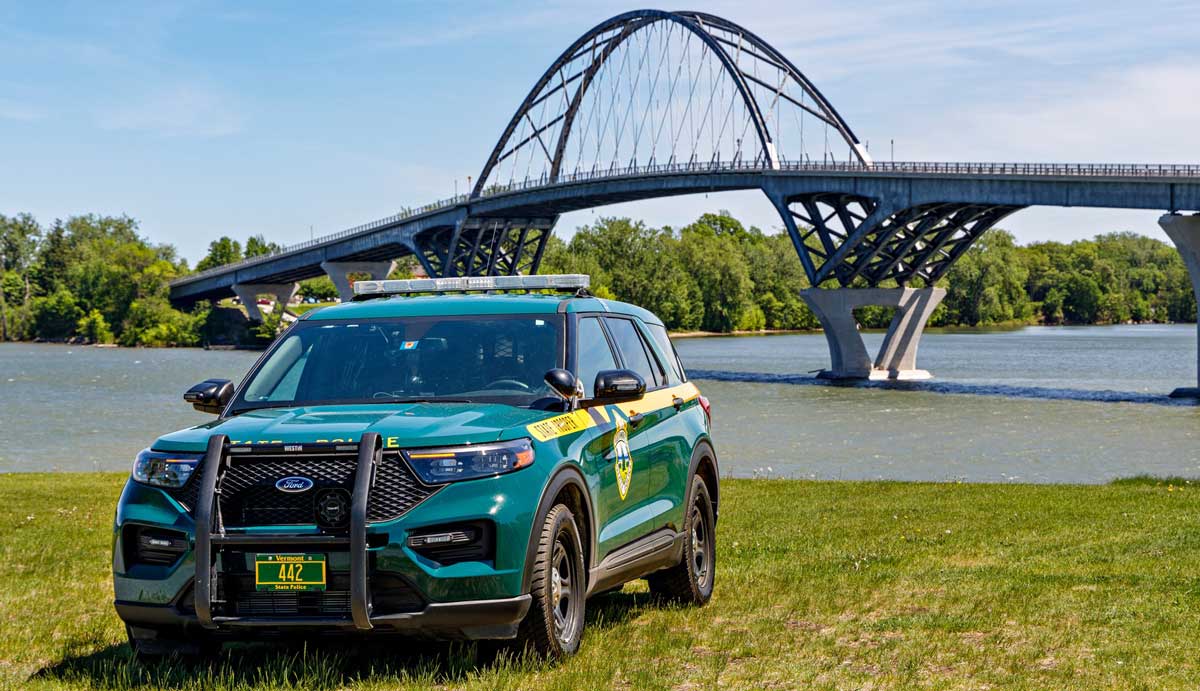
2022 ushered-in the 75th Anniversary of the Vermont State Police. As a result an initiative to design, launch and run commemmorative license plates for the occasion began in earnest.
The decision was to "go retro" and have the license plates look like their earliest versions from the infancy days of the VSP.
A clean design in green over white with VERMONT placed between the upper mounting holes and 75th ANNIVERSARY between the lower ones. STATE over POLICE on the far left center field of the plate followed by a number up to three digits.
These 75th Anniversary license plates were used into 2023.
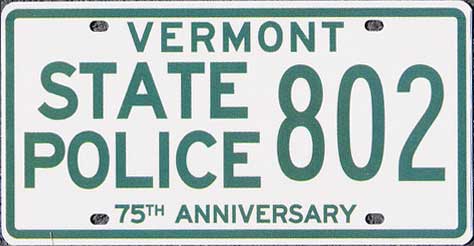 2022 75th Anniversary issue.
2022 75th Anniversary issue.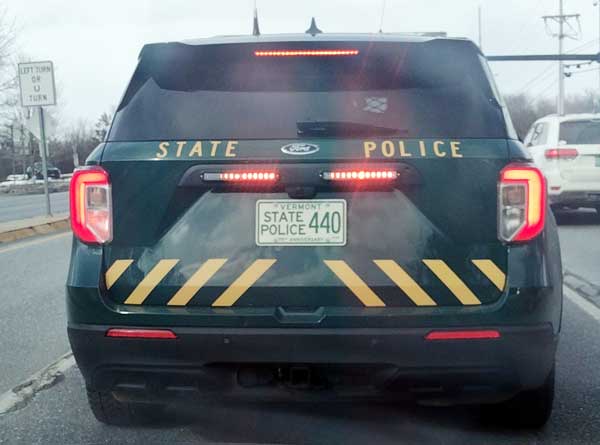 (Courtesy Russ Penka)...one of his old numbers from back in the day...1992 to 1997.
(Courtesy Russ Penka)...one of his old numbers from back in the day...1992 to 1997. 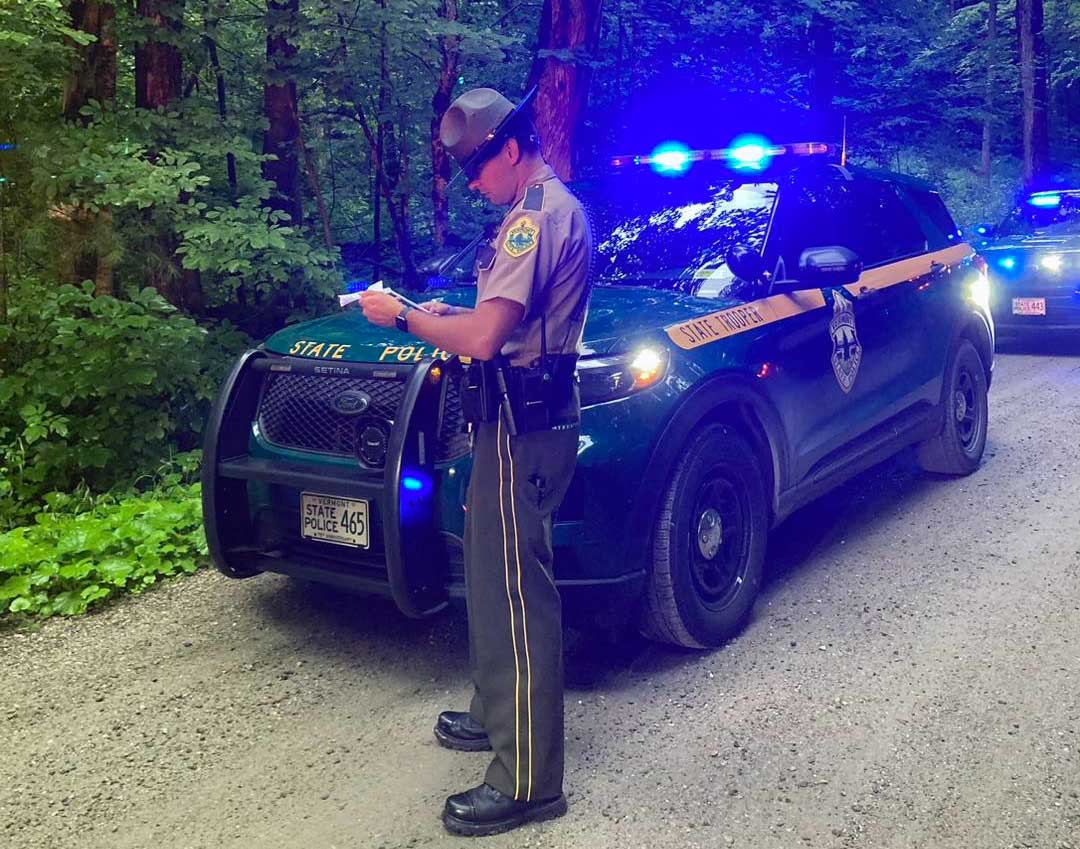
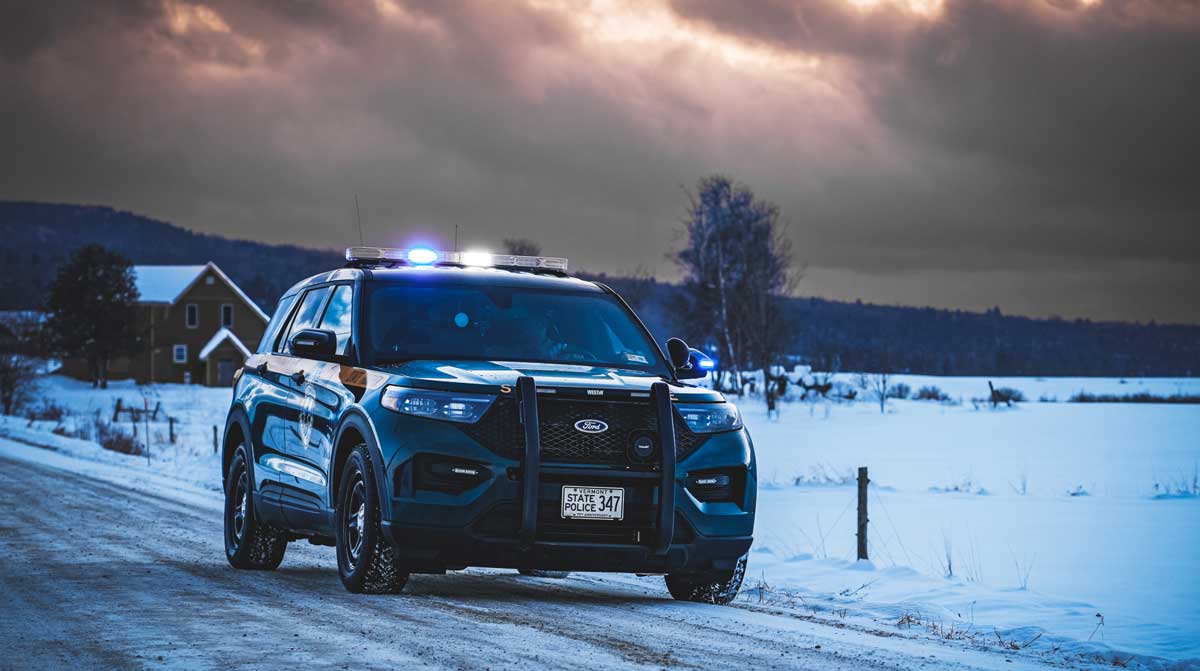
The Vermont State Highway Patrol utilized motorcycles during their mandate enforcing the state's traffic laws before the emergence of the Vermont State Police in 1947.
The VSHP had 3 motorcycles in 1931, up to 17 by 1933 and 27 of them when motorcycles were eliminated from the patrol fleet in 1937.
VSHP Inspectors had to purchase their own motorcycles, and the license plates used on these motorcycles were standard Vermont motorcycle plates with one to two digits.
There are only two confirmed types from this era:
1933- An embossed steel plate measuring 4 1/2" x 8 3/4" and colored white over dark blue. VT 33 was embossed over the number 15 and the plate had an embossed border also in white.
1937- An embossed steel plate measuring 4 1/2" x 8 3/4" and colored dark blue over white. VT occupied the upper left corner and 37 occupied the upper right corner, EXPIRES over MARCH 31 was embossed in the top center over the number 5.
It is likely that the 1937 Vermont motorcycle license plate number 13 seen below was used by the State Highway Patrol based on its number.
 Montpelier-April 30 1929- License plate numbers from left to right: 5, 232, 8, 79, 1 , (obscured), 9 (obscured), 2
Montpelier-April 30 1929- License plate numbers from left to right: 5, 232, 8, 79, 1 , (obscured), 9 (obscured), 2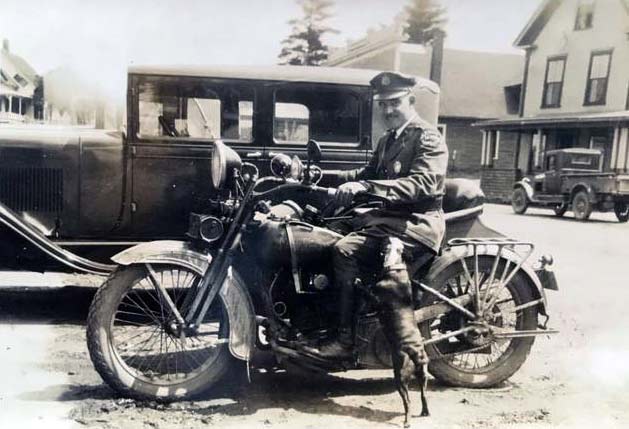 (Courtesy Gene Cote')
(Courtesy Gene Cote')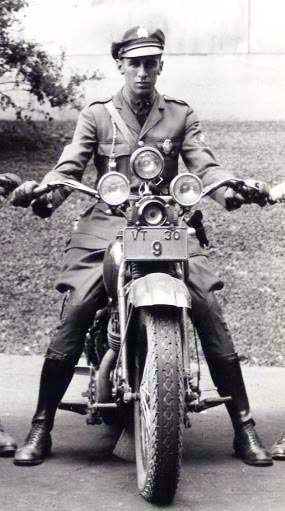 1930- Inspector E.A. Alexander who later went-on to become Colonel of the Vermont State Police.
1930- Inspector E.A. Alexander who later went-on to become Colonel of the Vermont State Police. 1930- Inspector George Lathrop with #2
1930- Inspector George Lathrop with #2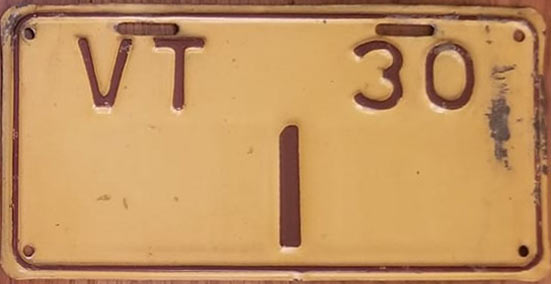 1930 Vermont motorcycle issue. Number 1
1930 Vermont motorcycle issue. Number 1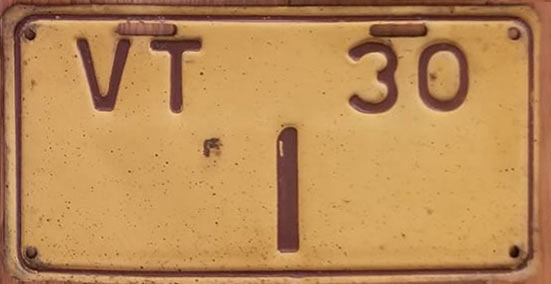 Mate to license plate seen at left.
Mate to license plate seen at left.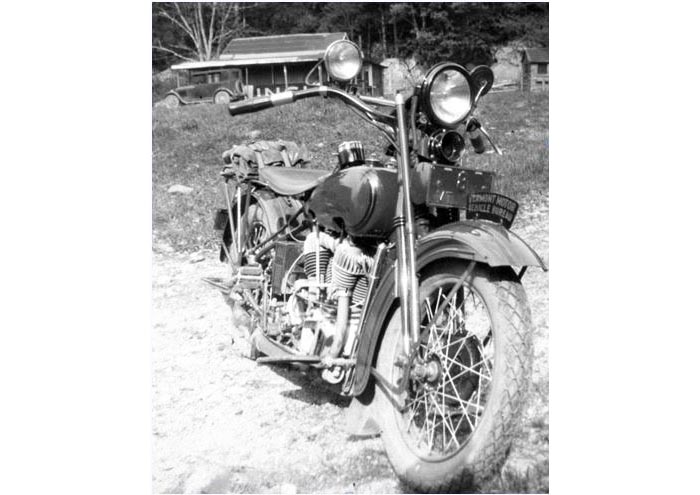 Clear view of fender sign reading VERMONT MOTOR VEHICLE BUREAU
Clear view of fender sign reading VERMONT MOTOR VEHICLE BUREAU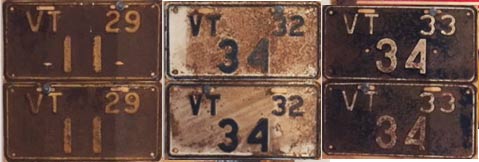 Two digit Vermont motrcycle license plates. The 1929 # 11's belonged to Inspector George Lathrop as seen above with the 1930 # 2 plate.
Two digit Vermont motrcycle license plates. The 1929 # 11's belonged to Inspector George Lathrop as seen above with the 1930 # 2 plate.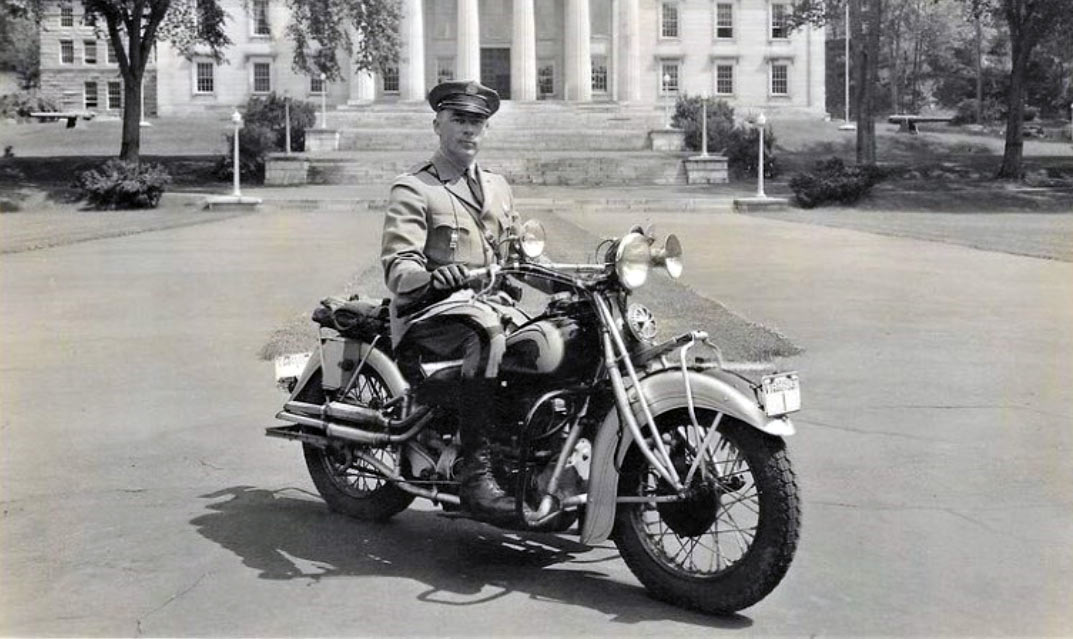 1937 Vermont motorcycle license plate #1. Issued to and run on the motorcycle of this Inspector with the state DMMV Highway Patrol.
1937 Vermont motorcycle license plate #1. Issued to and run on the motorcycle of this Inspector with the state DMMV Highway Patrol.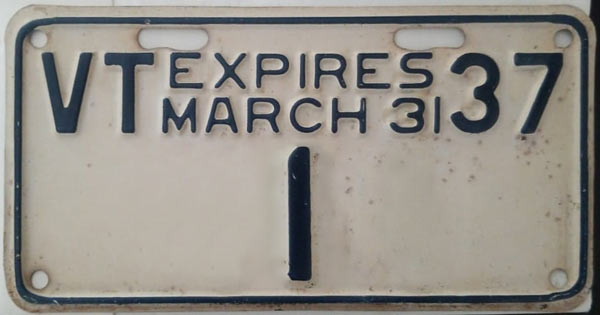 1937 motorcycle issue. Embossed steel.
1937 motorcycle issue. Embossed steel.
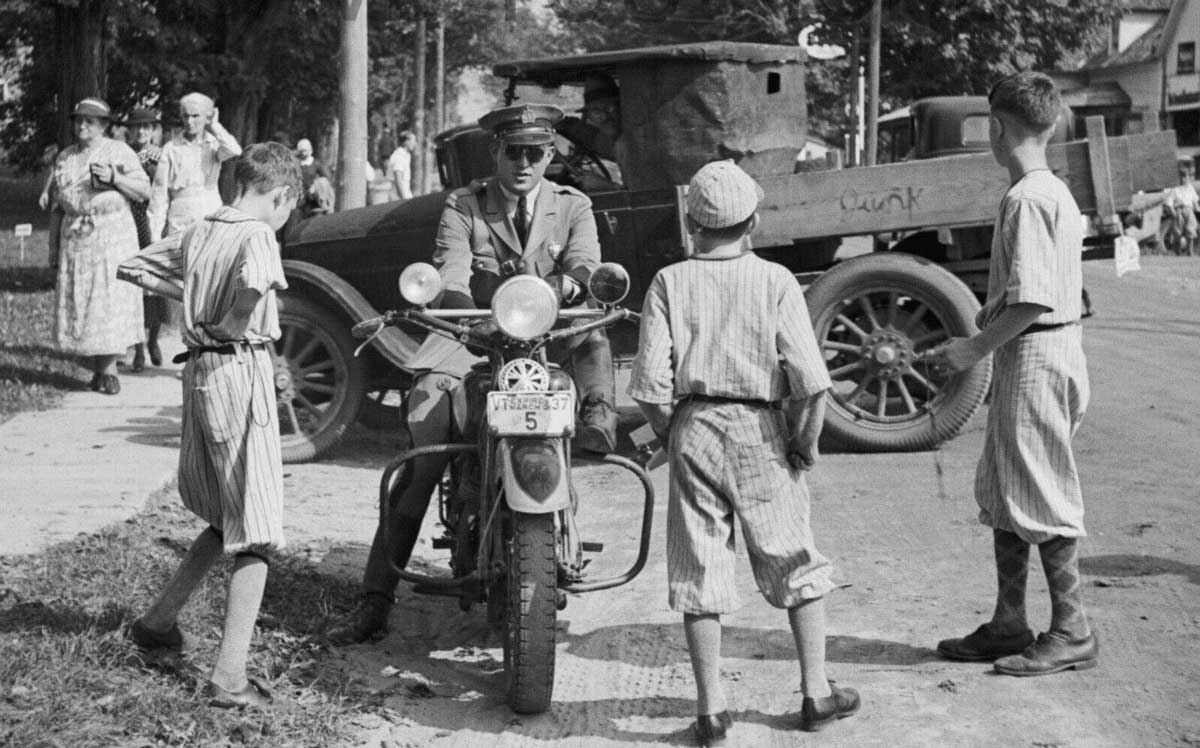 #5 making an impression on the young lads
#5 making an impression on the young lads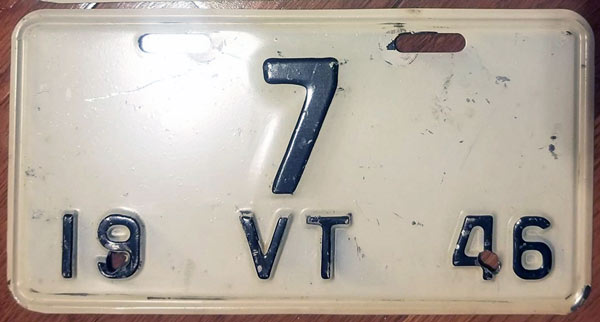 1946 motorcycle issue. Embossed steel.
1946 motorcycle issue. Embossed steel.
The Vermont State Police is not known to have ever incorporated motorcycles into its fleet.
The following are special issue license plates related to the Vermont State Police
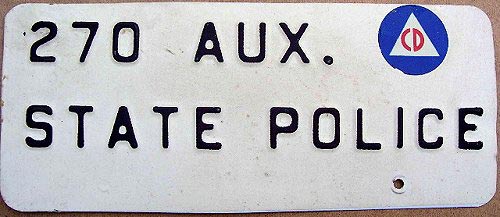 1963-1970 Vermont State Police Auxiliary attachment.
1963-1970 Vermont State Police Auxiliary attachment.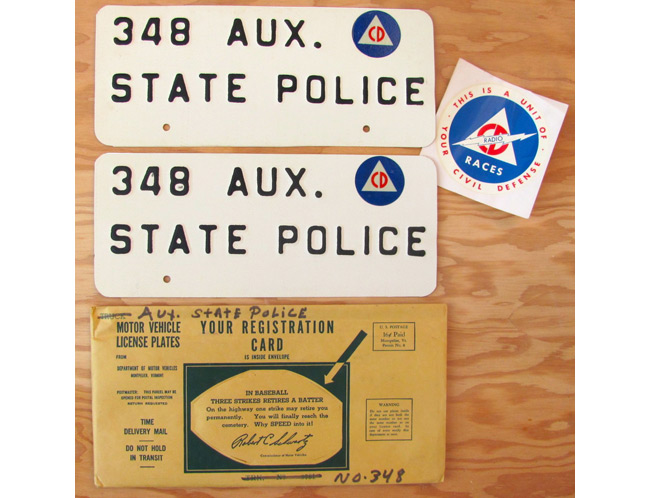
 1970's-1980's Countermeasures Related to Alcohol Safety on the Highways. A detail commenced in the early 1970's where a converted motorhome/bus registered to the state's Department of Health processed motorists for impaired driving by assigned VSP team members.
1970's-1980's Countermeasures Related to Alcohol Safety on the Highways. A detail commenced in the early 1970's where a converted motorhome/bus registered to the state's Department of Health processed motorists for impaired driving by assigned VSP team members.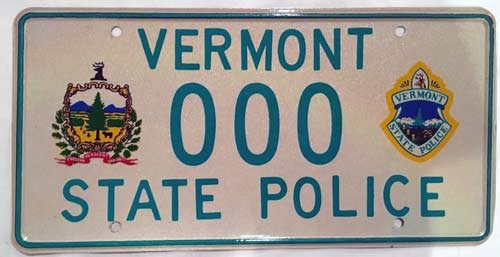 Graphic prototype sample.
Graphic prototype sample.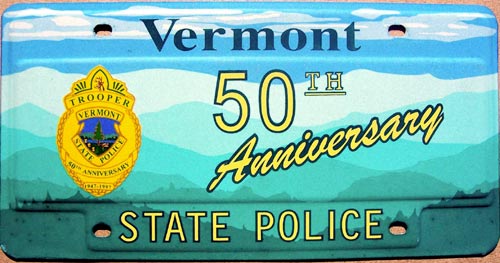 1997 50th Anniversary issue. Silkscreened aluminum.
1997 50th Anniversary issue. Silkscreened aluminum.
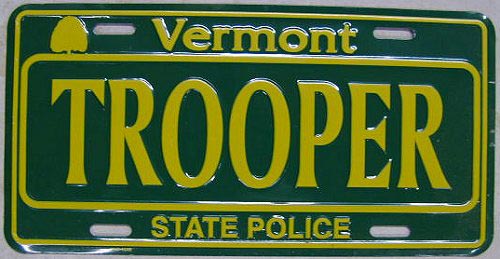 1989 National Troopers Coalition souvenir issue made by Vermont Trooper's Association
1989 National Troopers Coalition souvenir issue made by Vermont Trooper's Association 
 Vermont Motor Vehicle Bureau/Highway Patrol/DMV treasures.
Vermont Motor Vehicle Bureau/Highway Patrol/DMV treasures.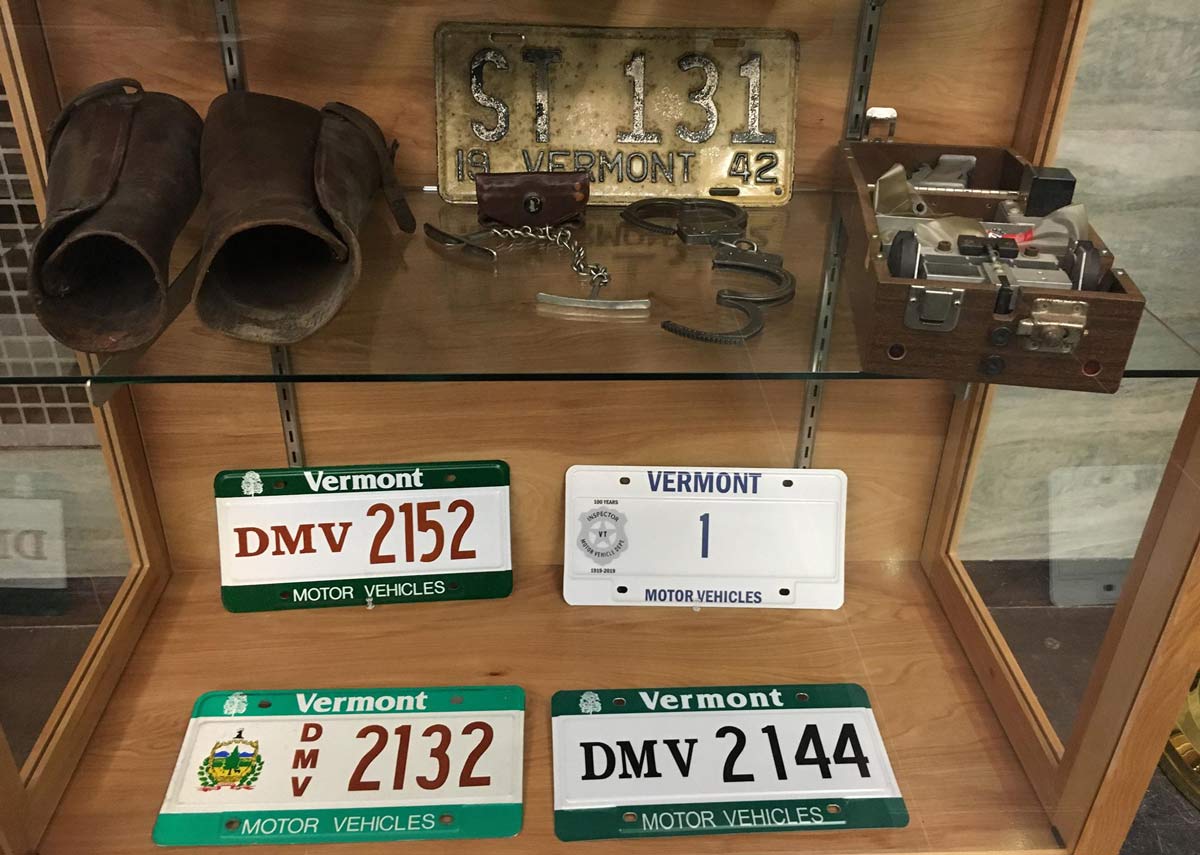 Vermont Motor Vehicle Bureau/Highway Patrol/DMV treasures.
Vermont Motor Vehicle Bureau/Highway Patrol/DMV treasures.